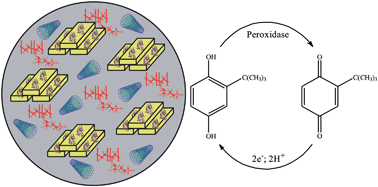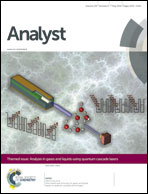Enzymatic biosensors based on ingá-cipó peroxidase immobilised on sepiolite for TBHQ quantification
Abstract
Sepiolite clay mineral was used as a support for the immobilisation of the peroxidase enzyme from ingá-cipó (Inga edulis Mart.) and was used with graphite powder, multi-walled carbon nanotubes (CNTs), mineral oil, and nafion 0.5% (v/v) in the development of a new biosensor for the determination of the antioxidant tert-butylhydroquinone (TBHQ) by square-wave voltammetry (SWV). For the optimisation and application of the biosensor, several parameters were investigated to determine the optimum experimental conditions using SWV. The best performance was obtained using a 0.1 mol L−1 phosphate buffer solution (pH 7.0), 4.0 × 10−4 mol L−1 hydrogen peroxide, a frequency of 50 Hz, a pulse amplitude of 60 mV, and a scan increment of 6 mV. The biosensor showed good repeatability and reproducibility and remained stable for a period of 20 weeks. The analytical curve revealed a linear response range of 1.65 to 9.82 mg L−1 (r = 0.994) with detection and quantification limits of 0.41 and 1.25 mg L−1. A recovery study of TBHQ in salad dressing samples yielded values from 99.6–104.8%. The proposed biosensor was successfully used for the determination of TBHQ in commercial salad dressing samples, giving a relative error of 5.4% in relation to the comparative method (chromatographic).

- This article is part of the themed collection: Analytical Sciences in Brazil

 Please wait while we load your content...
Please wait while we load your content...